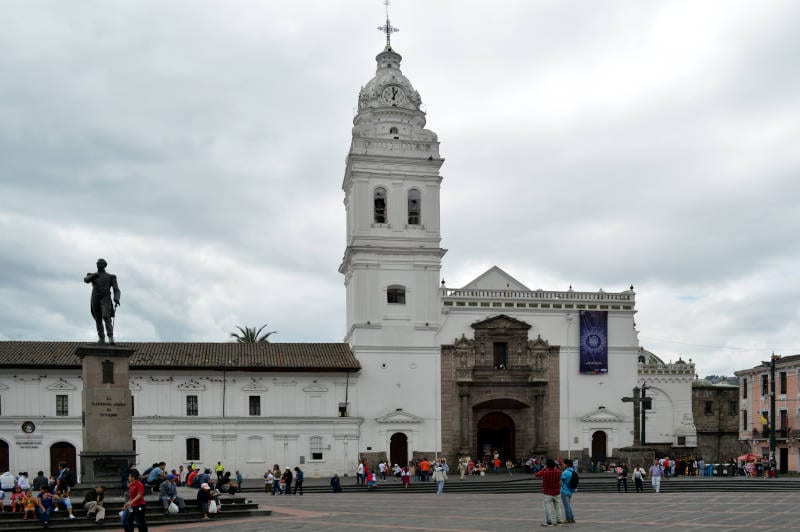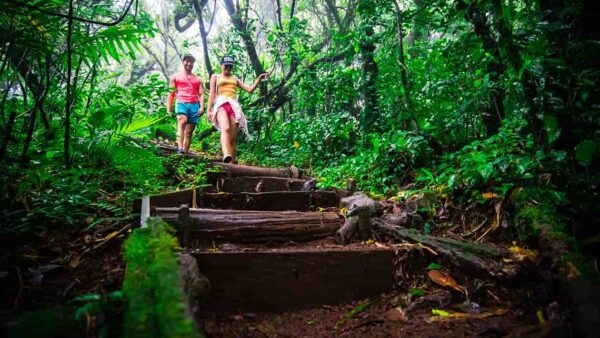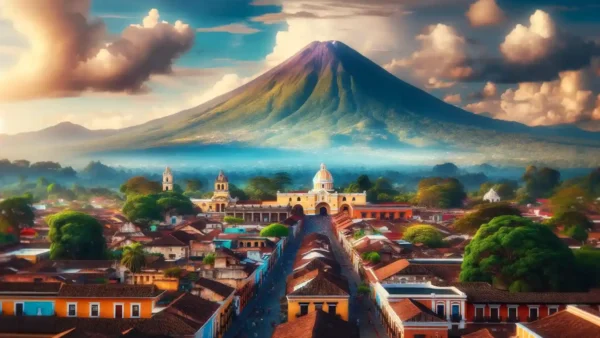Iglesia y Convento de Santo Domingo is also known as Basilica and Convent of Santo Domingo. the church is located in Central America‘s Lima District of Peru.
The Church and Convent of Santo Domingo holds a significant place in Peru’s history as the headquarters of the Dominicans who journeyed alongside Francisco Pizarro during his exploration of Peru.
Their crucial role warranted a prominent position in land distribution. Established just two blocks away from Pizarro’s former palace, this grand convent and church were situated in a vast block that diminished over time.
Originally named the Convent and Basilica of Our Lady of the Rosary, it was constructed between the 16th and 17th centuries, experiencing extensive reconstructions yet preserving remarkable treasures like the main cloister, the intricately designed coffered ceiling, and Sevillian tiles dating back to the early 17th century.
The site houses compelling canvases depicting the founder’s life and boasts Santo Domingo’s captivating library, the birthplace of the first university in America, San Marcos.
Notable within Iglesia y Convento de Santo Domingo church is the opulent neoclassical altar, notably featuring two altarpieces—one dedicated to Our Lady of the Rosary, a gift from King Charles the First of Spain, and another celebrating Peruvian saints, housing relics and sculptures like Saint Rose of Lima captured in mystical ecstasy by the Italian sculptor Melchior y Caffa in 1969.
Saint Rose and Saint Martin de Porres find their resting place here. The towering structure, once the city’s tallest sculpture, remains a striking feature, often photographed with the angelic trumpeter that crowned old Lima.
The Church and Convent of Santo Domingo, a gem of heritage in our bicentennial Lima, stands as a treasure waiting to be discovered.
The second cloister, a section that holds historical significance dating back to the 18th century, showcases remarkable Gothic architecture. The intricate design of tri-lobed arches and ogee arches, influenced by Gothic style, graces the upper and lower floors of this cloister, accentuating its architectural beauty.
This site, part of the Santo Domingo convent, holds immense historical importance, being one of the oldest in America and closely tied to the founding of Lima in 1572.
Furthermore, much of the land around the main square was allocated to the Dominican order by Francisco Pizarro during Lima’s founding. Properties along Jirón Conde de Superunda, including those in front of Plaza Perdón and the municipal palace, belonged to the Dominican order.
This chapel not only houses a significant collection of art depicting the patron saint of Lima but also features the image that is paraded through the streets every August 30th. Inaugurated in November 2017, this space holds the revered image of Santa Rosa de Lima, which previously graced processions before the pandemic. It’s adorned with numerous paintings and portraits by various artists, paying homage to Santa Rosa.
Among these captivating artworks, one particularly draws attention—the mortuary portrait of Saint Rose of Lima.
This remarkable piece, a replica of the original attributed to Italian painter Angelino Medoro from the early 17th century, is depicted here by the artist Georgia Palma.
The chapel is a treasure trove of history and artistry, showcasing the reverence and tribute accorded to Santa Rosa de Lima throughout the centuries.
Lima’s historic district, specifically block two of Jirón Conde de Superunda. The Osambela house stands before us, an architectural treasure from the colonial era. This area has undergone extensive restoration led by the Lima municipality since the beginning of the year.
At this point on block two, the meticulous restoration of the wall facing the square is underway, revealing the original colors of the historical church. Scaffolding and dedicated work signify ongoing restoration efforts.
Continuing the journey, the fully restored main tower of the Santo Domingo Convent is a testament to the recent completion of the bell tower’s restoration, marking a significant milestone in the larger refurbishment project of the convent’s exterior. Adjacent to it, the Veracruz chapel stands gloriously, having undergone splendid restoration.
Towards Santo Domingo Square, a recently renovated public space now boasts new furnishings, revamped paving, and enhanced lighting, adding to its charm and functionality.
Moving along Jirón Camaná, known as the Pozuelo chair block, ongoing pedestrianization efforts are evident, although occasional vehicle presence calls for stricter regulations.
Informative signage details the Santo Domingo Convent, showcasing meticulous restoration work on the church’s facade and dome as part of the comprehensive recovery program.
Block one of Jirón Camaná illustrates municipal cleaning initiatives, a visible testament to ongoing efforts to maintain the area’s historic appeal.
The restored colors adorning the Santo Domingo Convent reflect the meticulous recovery work undertaken by Prolimo and the Historic Center Recovery Program.
Arriving at Santo Domingo Square reveals the ongoing restoration efforts. Vehicular movement at Plaza Mayor emphasizes the need for better regulation to ensure pedestrian safety.
Attention returns to the Santo Domingo Church, with ongoing restoration work on the bell tower and Veracruz Chapel representing dedication to this ambitious restoration project as of mid-August 2023.
As this brief tour concludes, gratitude extends for being part of this immersive journey. Anticipate witnessing further strides in the recovery of this monumental heritage property within Lima’s historic center.
The renowned library houses around 25,000 antique books, some predating the Spanish conquest—a treasure trove for history enthusiasts. Notably, the monastery boasts famous paintings, including the 17th-century rendition of the Last Supper by friar Diego de la Fuente. This unique depiction showcases typical Peruvian ingredients, like guinea pig, potatoes, and hot peppers, adding cultural depth to the artwork.
However, the most intriguing aspect lies beneath—the captivating catacombs situated in the church’s basement. Housing thousands of skulls and bones, these catacombs once served as a burial site until 1808, when Lima’s primary cemetery opened on the city outskirts. Rediscovered in 1943, these haunting catacombs were eventually opened to the public in 1950, offering a chilling yet fascinating glimpse into Lima’s history and burial customs.
Iglesia y Convento de Santo Domingo opening timing is Monday to Saturday from 9am – 12:30pm and 3pm – 6pm, and Sundays from 9am – 1pm.
FAQ For Iglesia y Convento de Santo Domingo
Here’s a frequently asked questions (FAQ) section for the Iglesia y Convento de Santo Domingo:
Q: What can visitors expect to see at the Iglesia y Convento de Santo Domingo?
A: Visitors can explore a rich tapestry of history within this monumental complex. Highlights include the church, monastery, library, catacombs, and a myriad of historical artifacts, paintings, and architectural marvels dating back centuries.
Q: Are there any famous or notable features within the complex?
A: Absolutely! The complex houses a renowned library with an impressive collection of antique books, some predating the Spanish conquest. Visitors can also admire famous paintings, such as The Last Supper by Friar Diego de la Fuente, known for its depiction featuring traditional Peruvian ingredients.
Q: What are the catacombs famous for?
A: The catacombs are a significant attraction. Located beneath the church, they hold thousands of skulls and bones, serving as a former burial site. These catacombs provide insight into historical burial customs and were opened to the public in the mid-20th century.
Q: Is there an admission fee, and what are the visiting hours?
A: Admission fees and visiting hours may vary. It’s recommended to check the official website or contact the location for the most current information on entry fees, hours of operation, and any special tours or events.
Q: Are there any specific guidelines or dress codes for visitors?
A: As with many religious or historical sites, modest attire is usually recommended out of respect for the religious and cultural significance of the place. Visitors may be asked to dress appropriately, which may include covering shoulders or legs.
Q: Can visitors take photographs within the complex?
A: Photography policies might vary. Some areas within the complex may allow photography, while others might not. It’s advisable to check with the staff or consult posted signage within the premises for photography guidelines.
Q: Is there additional information or guided tours available for a more immersive experience?
A: Yes, guided tours may be available for visitors seeking a deeper understanding of the complex’s history, architecture, and significance. These tours often offer valuable insights provided by knowledgeable guides.
Q: Is the Iglesia y Convento de Santo Domingo accessible for people with disabilities?
A: Accessibility might vary. Some parts of the complex might be challenging to access for individuals with mobility issues. It’s advisable to inquire in advance about accessibility options for a comfortable visit.




